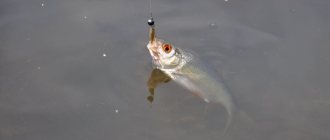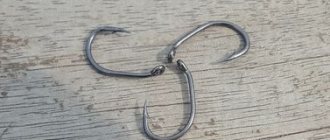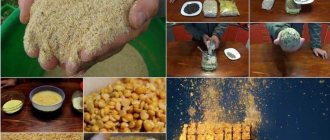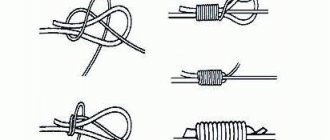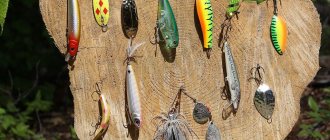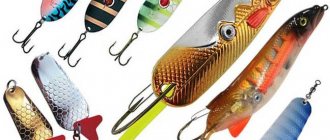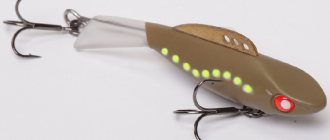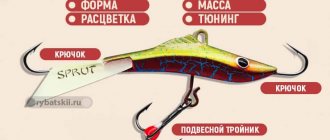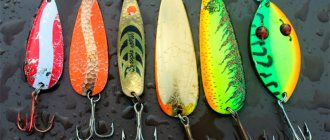One of the most common and popular spinning baits are spinners, which are divided into oscillating (in common parlance - spinners) and rotating (spinners). They differ from each other in different characteristics, which include the color of the spinner.
Spoons are made from various metals. Depending on this, they can have a reddish copper color, yellow brass or a whitish, shiny chrome color. The demons also paint with paints, applying interesting designs to them.
You can catch pike, perch, pike perch and even catfish with a spoon. Each fish has its own taste preferences for the color of the devil. Here are examples of working colors of spinners for pike fishing.
Coloring of spinners
Also, many baits are fully or partially painted with special paints. This allows you to create a spinner of almost any color or combination thereof.
For example, some models have a peculiar acid color. Many people are familiar with the color called “Black Fury”, which is a black background with bright dots of different colors: red, yellow, orange.
To catch perch or chub, spinners with a completely black blade are used. Asp are often caught using white spinners, which do not create a deterrent glare.
Spinner surface:
- Regular chrome and knurled chrome;
- Lead or tin;
- Polished copper, knurled copper;
- Polished brass, knurled brass, passivated brass;
- Brushed oxidized copper or brass;
- Bronze, silver (matte);
- Spoons with a painted surface.
With the variety of surfaces and colors of spinners, the situation is clear. But the question arises, which baits from a wide range to use in different natural and weather conditions, to catch different predators.
What color of spinner is preferable?
The color of the spoon is selected taking into account the type of small fish of what color is most common in a particular body of water.
For fishing in rivers where predominantly white fish such as roach and roach live, you should use spinners with light colors (“Chrome”, “Matte Silver” and others).
If fishing takes place on a still lake, quarry, or small ponds, the use of brass and copper spoons becomes more appropriate. In rivers where trout are found, point lures are used.
The influence of water transparency on the color of the spoon
Also, when choosing a spoon, you need to take into account the degree of water transparency. For fishing in muddy water, you should take bright baits (“Chrome”, “Acid”, the above-mentioned Black Fury” and others), while in reservoirs with clear water it is better to fish with spoons with a neutral color (“Chrome with a notch”, “Brass” with notches", various matte colors).
This is due to the elementary visual features of fish, which in dark water may simply not notice your bait, and in a clear reservoir, too bright colors and glare will scare them away.
The best colors of spinners for pike fishing
I have a question about choosing spinning lures. Tell me, what color of spinner does pike prefer in the fall and warm season? Is it true that the color of the bait is not very important?
It is generally accepted that among anglers there is still no consensus on the importance of bait color for catching pike. Some of them defend the theory of skillful presentation of the spinner without taking into account design excesses. Opponents argue that the shades of a twister, wobbler or spoon play a key role for a successful bite. If you look at the problem from a neutral angle, you can see the main thing: both of them rely on the peculiarities of the biology of the predator, which, when hunting, first of all trusts its vision, and then its smell, hearing and lateral senses. That is why, by correctly choosing the best colors for pike fishing for a specific river, pond, lake and meteorological conditions, you can count on a richer and larger catch.
The basic criteria for choosing a color for a pike are:
- dull color for sunny days;
- bright colors for cloudy weather;
- gloomy shades for dark water;
- catchy coloring, including acidic, for a muddy body of water.
In morning and evening twilight, cloudy weather, and rain, every reflection of the sun is important, which will give the bait a resemblance to fish scales. Glossy, bright lures that reflect light well are suitable. And, conversely, on fine days in clear water and in shallow water, it is better to avoid using baits that frighten the predator with their unnatural sparkle. When fishing at great depths, this problem goes away on its own due to insufficient water transparency, but the nuance of the bottom shade becomes important, since the likelihood of a pike attacking from the upper direction increases. If the reservoir has a sandy base, you need a contrasting bait of a dark color. Accordingly, for a clay, rocky or silty bottom, a light-colored spoon is selected.
To learn more:
Mainline boilies for carp fishing
In order to quickly adapt to fishing conditions and not be left without a trophy, you need to have a set of baits of different colors:
- natural - silver, brass, bronze, imitating carp species;
- acidic (neon) - light green, orange, yellow, fuchsia;
- perch shades - green-black, golden-brown, emerald-wheat stripes;
- dark – brown, red, black, olive.
It is important to always have a bait that imitates perch - this species is a food competitor of pike and is being exterminated en masse by it. Variegated acidic colors are clearly visible in any water and irritate the predator, provoking a rapid attack. In autumn, the best colors for pike fishing are silver, red, gold tones and their combinations.
The influence of weather on the choice of spinner color
Lighting conditions also play an important role. It is traditionally believed that on sunny days with good weather, predators are much more likely to fall for dark matte spoons, brass or copper baits, and on bad weather with heavy clouds they prefer bright baits of acidic colors.
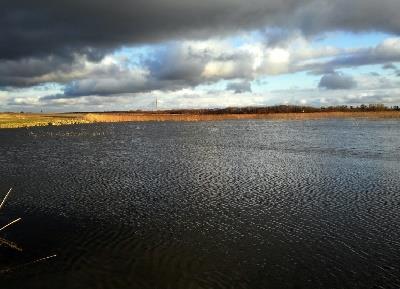
In twilight conditions, it is appropriate to use black spinners. However, you should not be too categorical about this distribution, since numerous cases from fishing practice can refute the above-mentioned strict rules.
Experiment and find an individual approach to the conditions of your pond.
Checking the MOST CATCHABLE colors of oscillating spinners for pike under ultraviolet light
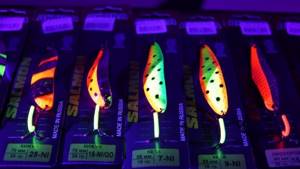
With the development of the fishing industry, the range of lure colors offered to us by various manufacturers has increased significantly. Entering a modern fishing store, your eyes are simply wide-eyed at the abundance of all kinds of colors of spinners, wobblers and rubber. And in all this diversity, not only a beginner, but also an experienced fisherman can get lost. Which color should I choose? Are all these “colorful” spinners really necessary? Who needs them more, the fisherman or the fish? Again, the age-old question comes up, about which there are so many fishermen, so many opinions: do fish even distinguish colors under water?
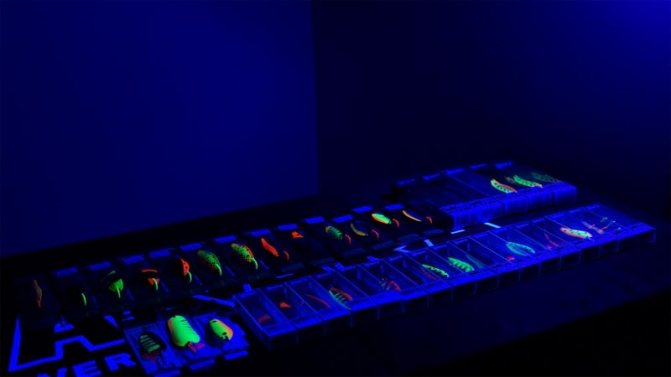
And of course, the question that has become relevant in recent years is: does the bait glow in ultraviolet light? So we tried to figure it all out using the example of oscillating spinners.
Personally, I believe that fish distinguish colors and it is necessary to have a fairly wide range of lure colors in your arsenal, but of course without fanaticism. After all, if you go back to the roots and remember how it all began, then the variety of spinners on the shelves was not so wide. Oscillators were mainly in several versions: silver, copper, brass and bronze. And they differed only in that some of them were shiny, and some were matte. After some time, vibrators of bright acid colors appeared. And deciding which lure to choose at this particular moment was not so difficult. If the water is cloudy or the weather is cloudy, then put something brighter, or shiny silver or gold, or “acid”. If the water is clear and the sun is shining, then vice versa: matte spoons, copper or bronze in color, are used...

Nowadays the situation is somewhat different. Of course, before there were more fish, and they were not so spoiled by the abundance of baits offered to them. In addition to everything, at least it seems to me, fish also learn and “evolve” over time, especially in pressurized water bodies near the capital. In order not to drown in all this abundance of colors and figure out exactly what kind of spinners you need to have in your box, we decided to shed ultraviolet light on them and tried to somehow sort it all out. But, again, I repeat, this is my personal opinion, and it does not claim to be true. So write your opinion on this issue, we’ll try to figure it out together.
In this video we check the best and most catchy colors of oscillating spoons for pike and perch under ultraviolet light from the Akara brand. Let's look at the classics: Atom, Blackback, Storling, Cleo, and others - Laxa, Viskan, Horgen, an analogue of the meps cyclops. We looked at the game of spinners under water, talked about their features and which ones and when are best to use when fishing.
Lure color for perch
The situation with pike and perch fishing is similar. For him, the play of the spinner, its shape, is more important, and the color must be selected taking into account weather conditions, the color of the “food” small fish in the pond, etc.
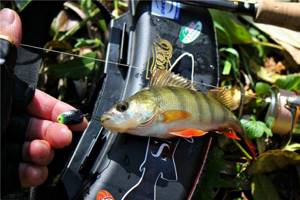
The color of the spoon plays a more significant role when catching asp or chub, which are much more often caught on bait with a matte surface.
Fishing technique
When fishing for pike, you need to keep the line under constant tension. If the fish is not too large, then bringing it to the surface will not be too difficult. With a larger one you will have to tinker, but the fishing technique will be exactly the same.
Regarding the time and place of habitat of pike, it was already mentioned earlier. It is worth noting that a bite does not mean that the fish is 100% caught, since it is very important to correctly bring it out of the water onto the shore or into the boat. To do this, there must be a friction brake on the reel, due to which the fishing line can be gradually reeled in, and it will not unwind in the opposite direction.
This feature of the reel allows you to keep the fish on the hook even during jerks. Moreover, it will also help when the fish jumps out of the water, weakening the fishing line, trying to throw off the hook.
By season
During the summer months, fish activity is not very uniform.
In June, the water has not yet fully warmed up after winter and spring floods, so there is not a lot of vegetation in it that could accommodate the catch.
The water gets quite warm in the shallows where small fish congregate. Predatory fish also come there. At this time, pike will be perfectly caught both with bait and live bait.
Literally after a month, the water becomes much warmer, the pike becomes more picky in its diet. Her appetite decreases due to the fact that there is more vegetation in the water and less oxygen.
At this time, it is no longer found in shallow water. This is due to 2 reasons:
- It gets too hot for the pike itself
- Due to rising temperatures, even small fish move to deeper water;
Due to the heat, the pike itself becomes lethargic and sleepy, and therefore it bites only in the evening and morning hours. It is quite easy to determine the location of the pike - it is found under snags, in small holes or in the grass, but it itself does not bite very often.
Some fishermen try to catch fish on the surface of a reservoir, because catching sluggish and half-asleep fish from the bottom of a reservoir is often almost impossible.
Also, pike is very fond of areas of reservoirs where springs or springs gush from the bottom. There is no point in looking for it in silted areas, since decay processes are already taking place in these areas, which pike cannot tolerate at all. Most often, it bites in the morning, but in cloudy and cool weather you can try to catch it throughout the day. If there is a thunderstorm in the forecast, then right before it starts the fish bite even more actively.
Often, pike can bite during rain, because in this case there is more oxygen in the water, which makes the fish more active. Hungry after hot weather, fish begin to actively hunt, as a result of which the likelihood that it will be caught is much higher.
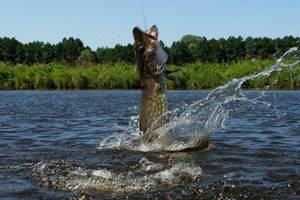
After the August rains, the water becomes much cooler, saturated with oxygen, the layers in it mix, thanks to which the pike regains its former appetite.
Depending on the fishing period, spinners are taken in different sizes. For example, at the very beginning of the summer season, the size of the bait should correspond to the size of the fish. The fact is that the pike food has not yet had time to grow normally, as a result of which the spinners are also selected in small sizes.
Depending on the weather, pike activity may vary, so the size will also vary. Most often, “spinning spoons” No. 2 and 3 are purchased. In July, it is best to use spinners, the size of which is in the range from 4 to 8 cm.
